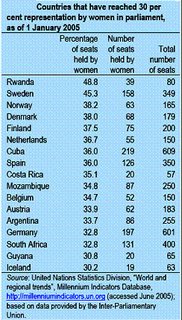40 Gender Parity (or lack thereof) in Canadian Electoral Politics, II

Women are vastly underrepresented in Canadian representational politics -- at all levels. The numbers are pathetic.
At the federal level, this time around, women constitute a mere 23.2% of candidates.
The raw data:
* Only 380 women (as opposed to 1,254 men) are running for parliament. Some ridings have no women candidates in any party -- you can only potentially vote for a woman in 78.2% of ridings.
* O.k., yes, that's an improvement since the days of Agnes Campbell McPhail (the first woman elected to the House of Commons, in 1921). But the number of women candidates actually fell from 2004. And the percentage of women who are actually elected has, lately, been even lower than the percentage of women who run for government -- 16.62% (in 2000 and in 2004).
* The party with the highest percentage of candidates who are women in this election? The one-woman-party Animal Alliance Environment Voters, at 100%, followed, at a long distance, by the New Democrats at 35.1%, also the party with the highest number of women candidates, 108 (as opposed to 200 men -- no transgender candidates are listed by any party).
* The Progressive Canadian and Marijuana parties are nearly tied for last place in terms of gender parity, at around 4% -- or, one woman candidate. But the other three major national parties aren't lagging too far behind:
* The Conservative Party boasts 38 women (versus 270 men), or 12.4%. No big surprises there.
* The Liberal Party is running 79 women (as opposed to 229 chubby-jowled white men), i.e., 25.6%. Well, that's easily explained: not many shipping magnates are women.
* And the Bloc Québécois 23 women (and 52 men), or 30.7%. Tabernacle.
As for aspiring national parties, the Green Party is hovering at the standard set by the Liberals - 72 women or 25.3%. But then, voting for any Green, man or woman, is voting for Mother Nature. Uh, right. And the Communist Party is running 7 women, or 33.3% -- don't worry, they're for the elimination of gender oppression...after the revolution.
So, in the 2004 election, 65/308, or 21.1% of parliamentarians were women. How does this compare to other nation-states? No nation has perfect parliamentary parity. But some states -- especially those engaged in post-war and post-colonial reconstruction -- have quotas that aim for parity; Canada does not. Since 2003, Rwanda has the highest percentage of women in its parliament, at 48.8%, or 39/80 seats. This is the closest any national government in the world has come to equal representation of women. Yet women have only had the right to vote in Rwanda since 1961.

Source: UNFPA
The current heads of government who are women (all nine of them) could fit around my dinner table (if we squished a little). Not that I'd very much like to invite many of them... Listing past women heads of government would take about 1 minute (there are thirty). If invited to a dinner party, Thatcher's first move would be to slash appetizers (the main course would soon be similarly imperiled). Bhutto and Macapagal-Arroyo would exchange stories of corruption ad nausaeum. Throughout, I'd be worried that Meir would decide to set up house in my apartment. And Campbell would leave no sooner than she walked through the door, to many exclamations of "good riddance."
What explains this global state of affairs? Why are women in this overdeveloped country underrepresented? Maybe Jack Layton has it the wrong way around: electing more women to government might not change things, but we need to change things in order to elect more women to government. And then, we need to elect women who change things.
What explains this global state of affairs? Why are women in this overdeveloped country underrepresented? Maybe Jack Layton has it the wrong way around: electing more women to government might not change things, but we need to change things in order to elect more women to government. And then, we need to elect women who change things.

0 Comments:
Post a Comment
<< Home